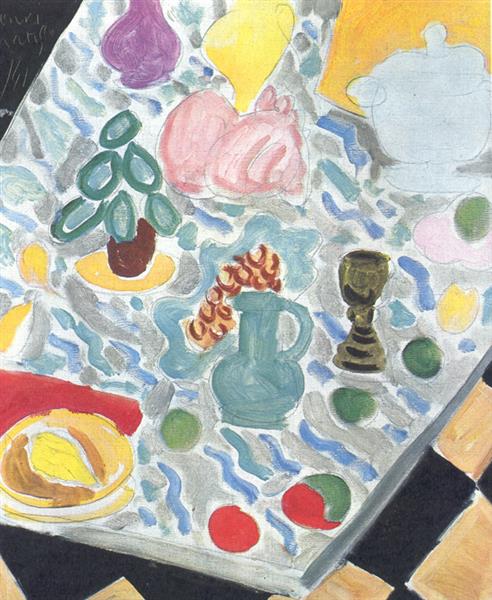Description
In the vastness of modern art, the figure of Henri Matisse stands out as a titan who, with his vivid use of color and form, redefined the visual and emotional perception of pictorial art. One of the most sublime examples of his mastery in the still life is the work "Still Life with a Marble Table" from 1941. This piece, which measures 50x60 cm, encapsulates the unmistakable essence of Matisse's mature style, characterized by a bold use of flat colors and a structured yet lyrical composition.
At first glance, we are greeted by a composition centered on a marble table, whose texture and cold shine become palpable through Matisse's mastery of stroke. On this table are arranged several everyday elements: a bowl of fruit, a bouquet of flowers in a vase, and a ceramic figure. Each of these objects has been represented with an economy of detail that emphasizes their form and color more than a photorealistic capture. Here, Matisse displays his ability to synthesize the essence of objects without resorting to unnecessary complexity.
The use of color in this work is particularly striking. Matisse uses vibrant and contrasting tones to generate a sense of vitality and harmony. The oranges and reds of the fruits complement and stand out against the green and blue tones of the leaves and background. This chromatic choice is not accidental; Matisse understood color not only as a decorative element but as a vehicle to convey deep emotions and sensations, thus managing to communicate a sense of warmth and serenity that transcends literal representation.
The marble table, the central axis of the composition, not only acts as a physical support for the objects but also symbolizes a firm and stable structure around which domestic life is organized. This contrast between the firmness of the marble and the softness of the organic objects on it reinforces the duality between the permanent and the ephemeral, a recurring theme in Matisse's work. Additionally, the slightly elevated perspective from which we observe the scene invites us to an act of serene, almost meditative contemplation.
The still life, traditionally a minor genre within painting, acquires a new dimension in Matisse's hands. In "Still Life with a Marble Table," he does not merely represent inanimate objects; he elevates them to a higher aesthetic category, where each component integrates into a visual symphony. The absence of human characters does not in any way diminish the warmth and humanity of the scene; on the contrary, it allows the viewer to project their presence and personal experience into the act of contemplation.
It is impossible to talk about this work without contextualizing it within the tumultuous period in which it was created. In 1941, during the height of World War II, Matisse took refuge in the southern zone of France, seeking both peace and a continuation of his creative process. The serenity and stability conveyed by his still lifes during this period can be seen as a conscious counterpoint to the chaos and uncertainty of the outside world.
In conclusion, "Still Life with a Marble Table" is a work that, through its apparent simplicity, reveals the depth of Henri Matisse's artistic vision. Every stroke, every color, every empty space speaks of an master in full control of his art and his ability to transform the ordinary into a bastion of beauty and contemplation. It is an invitation to pause, observe, and discover in everyday life a universe of nuances and emotions.

